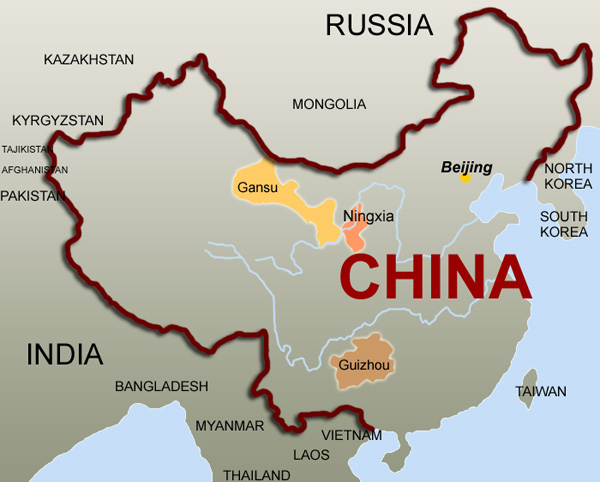In China's poorest places, Stanford researchers experiment with cash incentives to improve children's health
Our series: Stanford's Rural Education Action Project in China
China is the world's fastest-growing and second-largest economy, but it's the country's poverty that keeps Scott Rozelle coming back. As co-director of Stanford's Rural Education Action Project, Rozelle is looking for ways to give those struggling in the country's most remote areas the chance to make a living in the booming cities. REAP is one of many programs that has benefited over the last four years from The Stanford Challenge, a fundraising campaign dedicated to supporting people and programs seeking solutions to global problems.
For the past three summers, Rozelle has led what he calls a "mobile board meeting" of REAP's researchers, collaborators and donors who get a chance to review some of the group's projects and think up new ones. This year, the entourage focuses on REAP's work to eradicate childhood anemia and intestinal worms, and introduce computer-assisted learning in schools.
The field trip covers some of the country's poorest areas in the Guizhou, Gansu and Ningxia provinces. Adam Gorlick of the Stanford News Service traveled with the group and reports on their experiences.
Part 6: Finding the right mix of information and money to yield results
NINGXIA AUTONOMOUS REGION, CHINA – When researchers from Stanford's Rural Education Action Project told Yang Zhengyang that more than 30 percent of his students were anemic, they gave the school principal a few tools to deal with the problem.
First, they provided training so he and his teachers could understand the iron deficiency, its link to low test scores and how the condition can be fixed with vitamins and a better diet. The researchers also gave him a cash subsidy to spend on anything he thought would reduce anemia. Finally, they promised him about $23 for every student who went from being anemic to having healthy hemoglobin levels within a six-month period between 2009 and 2010.
Yang took the subsidy – about $120 – and bought vitamins, meat and more vegetables for the 500 boarding students at the Yu Wang Central Primary School. And when those kids had their blood tested for a second time, 40 of them were no longer anemic. Yang was rewarded with about $920, roughly one quarter of his annual earnings.
That's big money in this part of China; it's been called the poorest place in the world. It's a region where crops barely grow, basic sanitation is practically nonexistent and childhood health problems such as anemia threaten to keep kids from getting the education they'll need to compete for good jobs in the cities – the ultimate frontier for China's burgeoning workforce and exploding economy.
"For 5,000 years it was OK to be anemic if you're never going to leave the farm," said Scott Rozelle, a Stanford economist and co-director of REAP who is experimenting with ways to improve children's health in rural China and get the government to adopt the most effective methods. "But we're looking 20 years into the future where there are much fewer farms and you need at least a high school education to make a living in the city."
Paying for performance
What happened at Yu Wang is a success story of what economists and policymakers call "paying for performance." The basic idea is that, given the proper financial incentives, people will figure out the most effective and innovative ways to improve their own conditions.
In a study of Yu Wang and 71 other schools in rural areas of Ningxia and neighboring Qinghai Province, REAP researchers found that principals who received a combination of information, subsidies and cash incentives wound up with lower student anemia rates than those who were given only information or a mix of information and subsidies.
And principals who were promised the incentive from REAP were even more successful in curbing anemia when they were also expecting a separate bonus from the government based on how well their students scored on standardized tests.
"Principals care about a lot of things besides anemia," said Grant Miller, an assistant professor of medicine at Stanford who led the research on the pay-for-performance experiment and is designing a follow-up study with a $2.5 million grant from the National Institutes of Health that will include about 300 schools.
"They may not be very interested in anemia, per se," he said. "But given existing incentives in many Chinese schools, they are definitely interested in good test scores."
So driving home the point that well-nourished children are more likely to be better students than their anemic peers may serve as a strong motivator.
But results can be uneven from school to school, and it takes some principals time to experiment with different strategies to find one that works.
At the Yang Lu Primary School a few hours away from Yu Wang, principal Li Hongyuan was given a similar package of resources and incentives when he was told that 28 percent of his students were anemic. But after following an almost identical plan of buying meat, vitamins and more vegetables for his students, their anemia rates barely budged.
Blame it on the winter
Turns out, the winter is at least partly to blame.
Cold weather meant it took longer for water to boil, a necessary step to make it safe for drinking in this poor, rural area. So rather than take the time to boil, cool and serve the water needed to chase the vitamins, Li told his students to take the caplets home and swallow them there.
The students were instructed to tell their parents they had to take the vitamins. But there was a clear disconnect between what happened at school and what happened at home.
Hai Fahua remembered her sixth-grade daughter taking some sort of pill she got at school, but she wasn't quite sure what a vitamin is. Then again, she said she isn't quite sure what anemia is.
She never heard anything from a school official about nutrition, but her daughter did tell her that a teacher said she should eat more vegetables, meat and eggs at home.
"I can't afford that," Hai said. Instead, she tries to fill her daughter's belly with rice and noodles.
Hai said she thinks the school should feed her daughter meat, but Li said nutrition is best left to the parents.
Communication breakdown
Yang, the principal at Yu Wang, where paying for performance worked, agreed that parents should be the ones responsible for feeding their children.
While he used his subsidy to improve the diets of the 500 students living at the school, he also reached out to the parents of the 700 kids who go home for their meals every day by sending students home with packets of information that explained anemia and stressed the importance of eating meat.
Despite some success, there was a communication breakdown with many families.
"There was a booklet, but I couldn't read it," said Yao Zhanmei, whose son and daughter attend Yu Wang. Like many of the other mothers who send their kids to this school, Yao is illiterate. But she's hopeful her children will do better than she has, making it to high school and maybe even college.
If she could read the booklet, its message to feed her kids more meat wouldn't really resonate. Not only are pork, beef and mutton too expensive, but she doesn't have a refrigerator to store it. And with the closest market a 45-minute walk from her house, she only buys ingredients that will last a while without refrigeration.
That means most meals consist of rice, noodles, potatoes and cucumbers.
"One thing we clearly learned from our study is that neither principals nor parents really understand anemia, even when we spend time carefully explaining it to them," Miller said. "But they care a great deal about school performance. Principals care because test scores are the basis of how they're judged and rewarded. And parents care because it is their kids' ticket out of poverty."
The gap in parents' understanding of anemia and the importance of good nutrition give Miller and his REAP colleagues new ground to test the effectiveness of paying for performance. Highlighting the link between a healthy diet and better school performance may help create demand for better meals and vitamins at the schools.
That, coupled with reinforcing cash incentives for principals, may be the key to tackling anemia in places like Ningxia where a good education is the best guarantee for a lucrative life in the cities far from this poor land.
- Part 1: Taking first steps toward fighting a pervasive parasite
- Part 2: Tackling a malady rooted in extreme poverty
- Part 3: To a barren plateau to address children's anemia
- Part 4: Solving the anemia problem: Is one egg enough?
- Part 5: Thin soup, mattresses of wood and a chance of ghosts
- Part 6: Finding the right mix of information and money to yield results
- Part 7: Computers help boost migrant children's grades



Share This Story